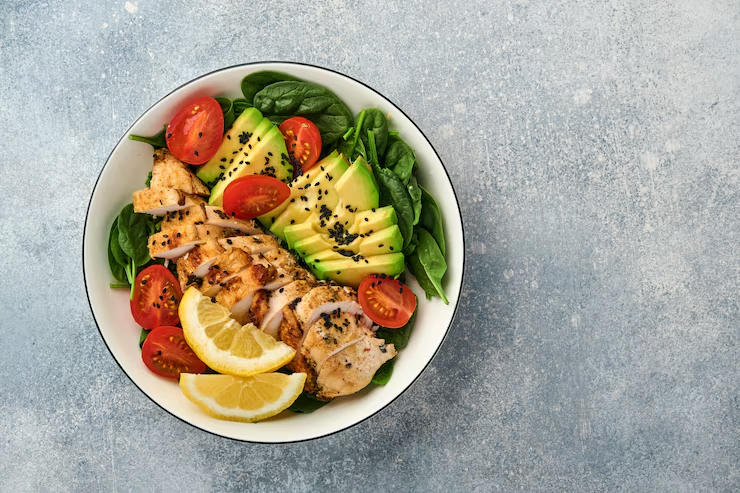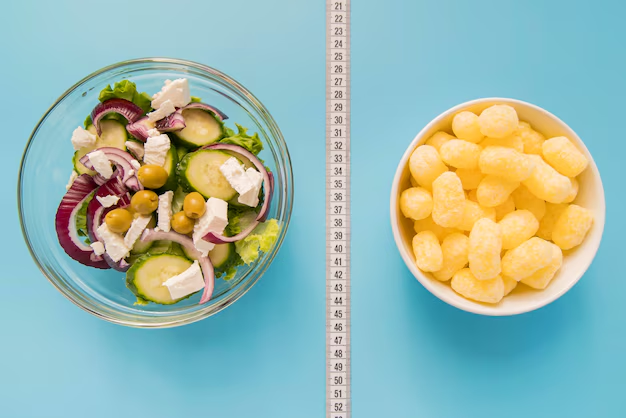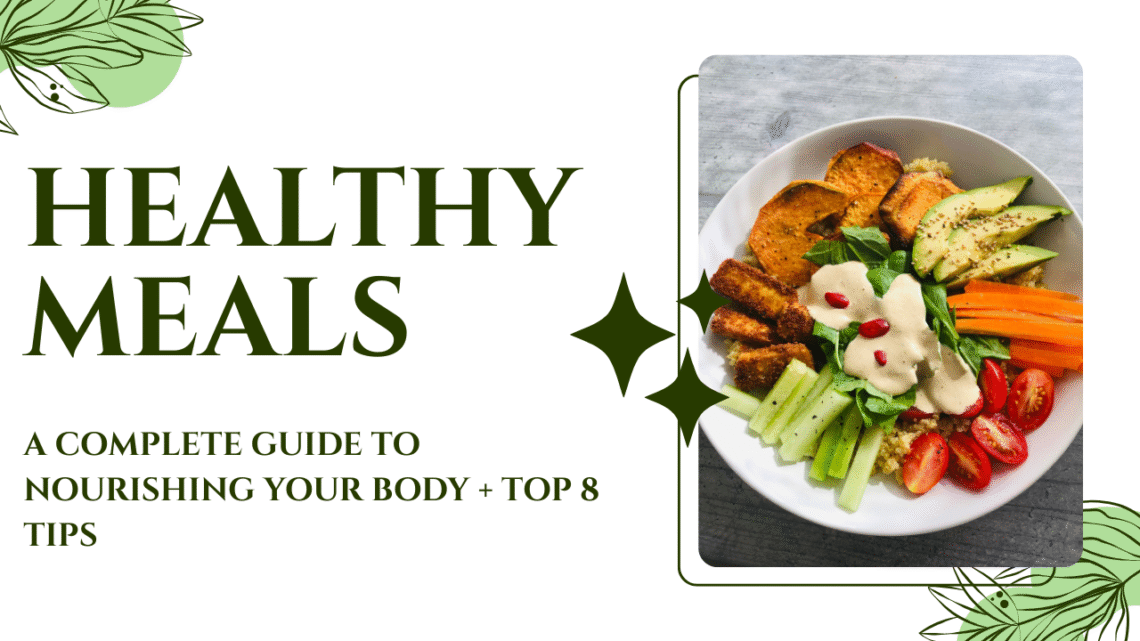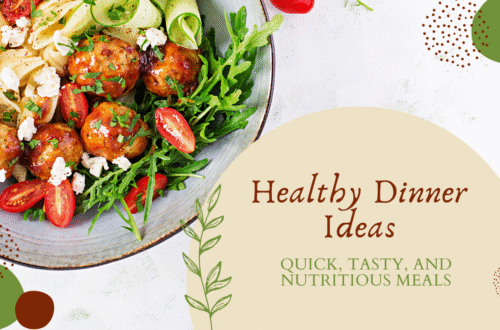Healthy Meals in today’s fast-paced world, healthy meals are more than a trend—they are a necessity. From boosting energy to reducing the risk of chronic diseases, eating well fuels your body, sharpens your mind, and supports your overall well-being. Whether you’re a busy professional, a parent planning family dinners, or someone looking to improve your diet, this guide on healthy meals will give you all the tools you need to make smart, delicious, and nutritious food choices.
In today’s fast-paced world, maintaining a balanced diet can be a challenge—but it’s more important than ever. Healthy meals are the foundation of a strong, energetic body and a clear, focused mind. They don’t just help with weight management; they also reduce the risk of chronic diseases, improve digestion, support heart health, and boost your immune system. Whether you’re trying to eat cleaner, manage a health condition, or simply feel your best, making smart choices around healthy meals can dramatically improve your overall well-being.
In this comprehensive guide, we’ll explore everything you need to know about preparing and enjoying healthy meals. From understanding the key components of a nutritious plate to learning how to cook with minimal oil and maximum flavor, you’ll discover practical, real-world strategies that fit any lifestyle or budget.
Most importantly, we’ll reveal the top 8 tips that can transform your relationship with food and help you create meals that are not only healthy but also satisfying and delicious. Whether you’re a beginner in the kitchen or a seasoned home cook, these tips are designed to help you succeed. Let’s get started on the path to eating better and living healthier—one healthy meal at a time.
What Are Healthy Meals?

A healthy meal is more than just a plate of food—it’s a smart combination of essential nutrients that fuel your body and support overall well-being. The core of healthy meals lies in balance, specifically among macronutrients: carbohydrates, proteins, and fats. Each plays a critical role in your body. Carbohydrates provide energy, proteins build and repair tissues, and healthy fats support brain function and hormone balance.
But truly healthy meals go beyond just macros. They are also rich in essential vitamins, minerals, antioxidants, and dietary fiber. These nutrients help maintain immune strength, improve digestion, regulate metabolism, and reduce the risk of chronic diseases. Incorporating a variety of colorful vegetables, lean proteins, whole grains, nuts, seeds, legumes, and healthy oils ensures your meals are nutrient-dense and satisfying.
Equally important is what healthy meals avoid—excessive sugar, sodium, refined carbs, and trans fats. Steering clear of ultra-processed foods helps prevent energy crashes, weight gain, and long-term health complications like diabetes or heart disease.
By focusing on fresh, whole ingredients and mindful portion sizes, you can create healthy meals that are both nourishing and enjoyable. This approach not only improves physical health but also supports mental clarity, mood stability, and a higher quality of life.
Key components of a healthy meal include:
- Lean protein (chicken, fish, legumes, tofu)
- Whole grains (brown rice, quinoa, oats)
- Healthy fats (avocados, olive oil, nuts)
- Fresh fruits and vegetables
- Low-sugar, low-sodium ingredients
- Adequate hydration (water-rich foods and fluids)
Why Healthy Meals Matter
Eating healthy meals consistently offers long-term benefits:
- Weight Management – Supports healthy body weight and prevents obesity.
- Heart Health – Reduces the risk of cardiovascular disease.
- Brain Function – Enhances concentration, memory, and mood.
- Energy Boost – Fuels your body efficiently throughout the day.
- Disease Prevention – Lowers the risk of diabetes, cancer, and hypertension.
- Better Digestion – High-fiber foods support gut health.
- Improved Sleep and Mood – Balanced nutrients promote hormonal stability.
Top 8 Tips for Healthy Meals
1. Prioritize Whole, Unprocessed Foods
Whole foods form the backbone of truly healthy meals. These are foods that are minimally processed and remain close to their natural state. Think fresh fruits, vibrant vegetables, whole grains like quinoa or brown rice, nuts, seeds, legumes, and lean sources of protein such as fish, chicken, tofu, or eggs. Unlike processed items that often contain hidden sugars, artificial additives, and unhealthy fats, whole foods deliver a rich array of nutrients that your body can recognize, digest, and use effectively.
When building healthy meals, always aim for ingredients that don’t come with a long list of chemicals or preservatives. A good rule of thumb is: if you can’t pronounce the ingredient, your body probably doesn’t need it. Swap out processed white bread for whole-grain or sprouted-grain options. Replace instant noodles and refined pasta with whole wheat or legume-based alternatives. These small changes can drastically improve your meal’s nutritional profile.
Whole foods help stabilize blood sugar, support digestion, enhance energy levels, and reduce inflammation. They are naturally high in fiber, which aids in satiety and weight management. By focusing on simple, natural ingredients, you can enjoy healthy meals that are not only delicious but also promote long-term wellness.
2. Balance Your Plate with the 50/25/25 Rule
This simple rule ensures nutritional balance in every meal:
- 50% vegetables and fruits
- 25% lean protein
- 25% whole grains or complex carbs
Example: Grilled salmon (protein), quinoa (whole grain), and a colorful salad (vegetables) drizzled with olive oil (healthy fat).
This balance helps regulate blood sugar, supports metabolism, and keeps you full longer.
3. Cook at Home More Often

One of the most effective ways to ensure you’re eating healthy meals is by cooking at home. Preparing meals yourself gives you complete control over the ingredients you use, the portion sizes you serve, and the cooking methods you choose. Unlike restaurant or takeout dishes—which often contain hidden sugars, unhealthy fats, excess sodium, and calorie-loaded sauces—home-cooked meals can be tailored to your specific health goals and dietary needs.
When you cook at home, you can use wholesome, fresh ingredients and avoid the additives and preservatives commonly found in processed foods. You can steam, bake, grill, or sauté instead of deep-frying, and you decide how much salt, oil, or seasoning to add. This level of control makes it easier to manage weight, blood sugar, and heart health.
Home-cooked healthy meals also promote mindful eating. You’re more likely to appreciate what you’re consuming, eat slower, and make better choices when you’re the one preparing the food. Plus, cooking at home can be a fun and creative experience, whether you’re trying new recipes, meal-prepping for the week, or involving family in the kitchen.
By choosing to cook more meals at home, you’re setting yourself up for long-term success in maintaining a healthier, more balanced lifestyle..
Bonus Tip: Try meal prepping—cook in batches and store meals in containers. It saves time and prevents unhealthy last-minute food choices.
4. Choose Healthy Cooking Methods
How you cook your food matters as much as what you eat. Opt for:
- Steaming
- Baking
- Grilling
- Sautéing with minimal oil
- Slow-cooking
Avoid deep frying and heavy cream-based sauces. For instance, steam vegetables instead of boiling to preserve nutrients, and grill chicken instead of frying it.
5. Add More Plant-Based Proteins
While meat and dairy can certainly play a role in a balanced diet, incorporating more plant-based proteins into your healthy meals offers significant nutritional benefits. Plant-based proteins such as beans, lentils, tofu, tempeh, chickpeas, quinoa, nuts, and seeds are not only rich in protein but also provide essential fiber, vitamins, and minerals that animal products often lack. Unlike many animal-based proteins, plant options are lower in calories and contain little to no saturated fat, making them heart-healthy and ideal for weight management.
Fiber, found abundantly in plant-based proteins, plays a key role in digestive health and helps keep you feeling full longer. This can reduce overeating and stabilize blood sugar levels. Moreover, reducing your intake of red and processed meats while increasing plant-based options may lower the risk of chronic illnesses such as heart disease, type 2 diabetes, and certain cancers.
Creating healthy meals centered around plant-based proteins doesn’t have to be boring. You can enjoy a variety of flavors and textures by combining legumes with whole grains, using herbs and spices for seasoning, or incorporating colorful vegetables. Whether you’re vegetarian or simply looking to eat more plants, plant-based proteins are a smart, satisfying, and nutritious choice..
Great options:
- Lentils and beans
- Chickpeas and hummus
- Tofu and tempeh
- Nuts and seeds
- Edamame
A hearty lentil soup, for example, is not just satisfying—it also supports heart and gut health.
6. Watch Portion Sizes

Even when you’re eating healthy meals, portion control plays a crucial role in maintaining a balanced diet and preventing unwanted weight gain. Just because a meal is nutritious doesn’t mean you can eat unlimited quantities. Overeating—even healthy foods—can lead to excess calorie intake and disrupt your health goals.
A practical way to manage portions is by using simple visual cues. For example:
- A closed fist equals about 1 cup, which is a good serving size for vegetables or grains.
- Your palm represents approximately 3 to 4 ounces—ideal for a serving of lean protein like chicken, fish, tofu, or legumes.
- Your thumb equals about 1 tablespoon, the right amount for healthy fats like olive oil, nut butter, or avocado.
These guidelines help you balance your plate without the need for measuring cups or calorie counting at every meal. When building healthy meals, aim to fill half your plate with colorful vegetables, a quarter with lean protein, and a quarter with whole grains or complex carbs. Add a small portion of healthy fat to round it out.
By being mindful of portion sizes, you can enjoy a variety of healthy meals while still achieving your nutritional goals, maintaining a healthy weight, and feeling satisfied—not stuffed.
Tip: Eat slowly, chew thoroughly, and stop when you’re 80% full—this helps prevent overeating.
7. Stay Hydrated with Water-Rich Foods
Hydration is often overlooked in healthy eating. Include water-dense foods in your meals:
- Cucumber
- Lettuce
- Watermelon
- Oranges
- Zucchini
Also, drink 6–8 glasses of water daily. Skip sugary drinks, sodas, and excessive caffeine.
8. Make Healthy Eating Enjoyable and Sustainable
Healthy meals shouldn’t feel like a chore. Explore new recipes, try global cuisines, and experiment with spices and herbs instead of relying on salt or sauces.
Ideas:
- Use cinnamon or nutmeg for sweetness.
- Try turmeric or cumin for warmth.
- Mix and match different colorful vegetables for visual appeal and varied nutrients.
When healthy meals taste great, you’re more likely to stick with them.
Healthy Meal Ideas for Every Occasion
Breakfast
- Oatmeal with almond milk, chia seeds, and berries
- Greek yogurt with nuts and sliced banana
- Whole grain toast with avocado and poached egg
Lunch
- Quinoa salad with chickpeas, spinach, cucumber, and olive oil
- Grilled chicken wrap with veggies and hummus
- Lentil soup with a slice of whole-grain bread
Dinner
- Stir-fry with tofu, broccoli, bell peppers, and brown rice
- Baked salmon with roasted sweet potatoes and asparagus
- Whole grain pasta with tomato-basil sauce and steamed greens
Snacks
- Carrot sticks with hummus
- Mixed nuts and seeds
- Apple slices with almond butter
- Hard-boiled eggs
Healthy Meals for Specific Goals
Weight Loss
- Focus on high-fiber, low-calorie foods like vegetables, legumes, and lean protein.
- Avoid empty calories from sugary drinks and desserts.
Muscle Gain
- Include high-protein foods (chicken, eggs, Greek yogurt).
- Eat balanced meals with carbs for energy and protein for recovery.
Diabetes Management
- Emphasize low glycemic index (GI) foods like oats, legumes, and non-starchy vegetables.
- Avoid refined carbs and sugary snacks.
Heart Health
- Choose omega-3-rich fish, nuts, and olive oil.
- Cut back on saturated fat, processed meats, and salt.
Common Mistakes to Avoid
- Skipping meals: Can lead to overeating later.
- Relying on processed “health” foods: Not all protein bars or “low-fat” labels are healthy.
- Ignoring food labels: Always check for added sugars, trans fats, and sodium.
- Overusing condiments: Sauces, dressings, and dips can add hidden calories and fats.
The Power of Planning Ahead
Meal planning makes healthy eating easier. It reduces impulse eating, saves time, and helps with budgeting.
Steps to start meal planning:
- Choose your meals for the week.
- Write a shopping list based on those recipes.
- Prep ingredients or meals in advance.
Use tools like meal-planning apps, freezer-friendly recipes, and reusable containers to stay organized.
Healthy Eating for Families and Kids

Creating healthy meals for families doesn’t have to be complicated or bland. Involve your kids in shopping and cooking—they’re more likely to try new foods. Make vegetables fun with dips, and sneak leafy greens into smoothies or pasta sauces.
Quick family-friendly ideas:
- Veggie-loaded homemade pizza
- Turkey and quinoa meatballs
- Sweet potato fries with grilled fish
Healthy Meals on a Budget
Eating well doesn’t have to be expensive. Buy seasonal produce, choose store-brand items, and shop at local markets.
Budget-friendly tips:
- Cook in bulk and freeze leftovers.
- Use lentils, eggs, and frozen veggies.
- Limit dining out and packaged snacks.
Conclusion: A Lifetime of Health Starts with Your Plate
Healthy meals are not about strict rules, deprivation, or striving for dietary perfection. Instead, they’re about nourishing your body, fueling your mind, and creating a lifestyle that supports long-term wellness. A truly healthy diet isn’t one-size-fits-all—it’s flexible, balanced, and enjoyable. The goal is to eat in a way that makes you feel energized, satisfied, and in control of your health.
Adopting healthy meals into your daily routine begins with a shift in mindset. It’s not about obsessing over every calorie or banning your favorite foods. It’s about adding more of the good—more colorful vegetables, whole grains, lean proteins, and healthy fats—while gradually reducing ultra-processed foods, sugary beverages, and empty calories.
Healthy eating becomes sustainable when it fits your lifestyle. Start by planning your meals ahead, cooking more at home, and learning to listen to your body’s hunger cues. Focus on progress, not perfection. If you slip, simply refocus on your next meal.
By making small, consistent choices, you can enjoy a wide variety of healthy meals that not only taste great but also support your physical, mental, and emotional health. Remember, every bite is a step toward a healthier, more vibrant life.
By following the top 8 tips and understanding how to build balanced meals, you can improve your health, save money, and gain energy—without sacrificing taste or satisfaction.
Here are 5 Frequently Asked Questions (FAQs) about Healthy Meals:
1. What defines a healthy meal?
A healthy meal includes a balance of macronutrients—carbohydrates, proteins, and healthy fats—along with fiber, vitamins, and minerals. It typically features whole, unprocessed foods like fruits, vegetables, whole grains, lean proteins (plant- or animal-based), and healthy fats such as nuts, seeds, or olive oil.
2. How often should I eat healthy meals?
Ideally, every meal and snack should aim to be healthy. This doesn’t mean being perfect all the time but making consistent, nutritious choices. Eating 3 balanced meals a day with 1–2 healthy snacks in between can keep energy levels stable and support metabolism.
3. Can healthy meals help with weight loss?
Yes. Healthy meals that emphasize portion control, fiber-rich vegetables, lean proteins, and whole grains can support weight management by improving satiety and reducing unnecessary snacking. Avoiding refined sugars and ultra-processed foods also helps prevent overeating.
4. Are healthy meals more expensive?
Not necessarily. Planning ahead, cooking at home, buying seasonal produce, and purchasing whole foods in bulk can make healthy meals affordable. Many budget-friendly staples like oats, beans, eggs, and frozen vegetables are highly nutritious.
5. Can I eat out and still have a healthy meal?
Yes. When dining out, choose grilled over fried options, ask for dressings or sauces on the side, and opt for vegetables or salads as sides. Many restaurants now offer healthy meal options—you just need to be mindful of ingredients and portions.





